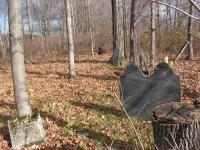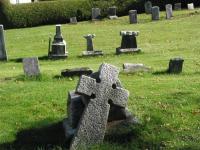 The Eastern Townships are known for the countless little cemeteries that dot the landscape in most parts of the region. The traveler of back roads will discover these burial grounds in virtually every hamlet, at deserted crossroads seemingly in the middle of nowhere, in farmers' fields, and on hilltops. Some have been unused for decades; others for considerably longer. Some are well kept. Others, more desolate, are overgrown with weeds and trees, the tombstones collapsed or broken. Some are situated in prime spots, with beautiful panoramic views.
The Eastern Townships are known for the countless little cemeteries that dot the landscape in most parts of the region. The traveler of back roads will discover these burial grounds in virtually every hamlet, at deserted crossroads seemingly in the middle of nowhere, in farmers' fields, and on hilltops. Some have been unused for decades; others for considerably longer. Some are well kept. Others, more desolate, are overgrown with weeds and trees, the tombstones collapsed or broken. Some are situated in prime spots, with beautiful panoramic views.
Each cemetery is worth a visit. Not only will the traveler find a sense of history among the headstones but tranquility as well. The weathered markers they contain speak to us of generations long since past. They echo still: Abijah, Japhet, Eleazer, Caleb, Eliza...
 Long ago, most villages, and even many families, had their own graveyards. Larger towns sometimes had more than one -- Protestant and Catholic, perhaps. As communities' fortunes rose and fell over time, families died out or moved away. In some cases, entire villages disappeared, and all that remained were their graveyards, which, with no caretaker, soon fell into disrepair.
Long ago, most villages, and even many families, had their own graveyards. Larger towns sometimes had more than one -- Protestant and Catholic, perhaps. As communities' fortunes rose and fell over time, families died out or moved away. In some cases, entire villages disappeared, and all that remained were their graveyards, which, with no caretaker, soon fell into disrepair.
In recent years, our early burial grounds have been seen increasingly as an important part of our heritage, worthy of preservation. Some of the so-called "orphan cemeteries" have been restored and are lovingly maintained by volunteer cemetery associations or local historical societies. Many others, however, have fallen into serious decay and are at risk of disappearing forever.
 In 2008, the Quebec Anglophone Heritage Network launched its Cemetery Heritage Investigation and Restoration Initiative (CHIRI). Conducted by Matthew Farfan, this study highlighted the deepening plight of pioneer graveyards across Quebec, and recommends solutions the problem. The study focused on 4 regions of the province: Estrie; Montérégie; Laurentides; and Saguenay Lac-Saint-Jean. QAHN also published a book, titled Cemetery Heritage in Quebec: A Handbook.
In 2008, the Quebec Anglophone Heritage Network launched its Cemetery Heritage Investigation and Restoration Initiative (CHIRI). Conducted by Matthew Farfan, this study highlighted the deepening plight of pioneer graveyards across Quebec, and recommends solutions the problem. The study focused on 4 regions of the province: Estrie; Montérégie; Laurentides; and Saguenay Lac-Saint-Jean. QAHN also published a book, titled Cemetery Heritage in Quebec: A Handbook.